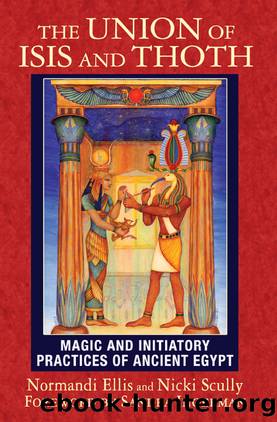The Union of Isis and Thoth by Normandi Ellis

Author:Normandi Ellis
Language: eng
Format: epub
Tags: Spirituality/New Age
Publisher: Inner Traditions/Bear & Company
Published: 2015-10-30T00:00:00+00:00
A history of the deity’s divine origins
Several powerful statements about that being’s divine powers
The ways in which the neter manifests on Earth and in our lives
A conclusion with a statement that solidifies the deity’s power
Normandi’s hymn “Song of Isis,” which appears in Dreams of Isis, is written as an aretology, a narrative hymn defining the qualities of the goddess. This form uses the first person; thus Isis can speak directly through you. Think about that as you write a hymn about your chosen neter, recording it in the voice of the deity. So in the “Song of Isis,” the goddess begins by saying: “Say my name . . .” At the sound of her name, Isis, the summoned goddess appears. She then bestows her blessing at the conclusion of the hymn.
The form of hymn writing, of course, can vary depending on the purposes both you and the deity are trying to invoke. Thus, the pattern will be rather free-form because, really, it comes straight from your heart. If you feel moved to write in rhymed couplets, do so; if you don’t, then don’t. You needn’t be attached to any particular form, as we are all evolving and we live in a different time from when the ancients lived. Again, what is important is your respect, your knowledge of the deity’s attributes, and your adoration, glorification, and gratitude for the specific neter. Each hymn is unique in its expression, and as long as it comes from your heart, it will achieve the desired effect.
In general, a more extensive hymn may include a list of the qualities the divine being possesses. These qualities, sometimes expressed as epithets, call attention to a particular attribute or characteristic of the god or goddess. For example, one hymn to Hathor includes her epithets “Lady of Flame,” “Radiant One,” “Golden Lady of the Mountain,” and “Mother of Us All.” It is an educational process to research these epithets. You can find the many epithets of the neteru online, and you can also parse your hymn from other hymns. For example, Psalm 104 in the Old Testament was parsed from the “Great Hymn to Aten,” composed by the pharaoh Akhenaten. Many other passages in both the New and Old Testament seem to echo the “Great Hymn to Aten.”*20
These hymns to the divine are glorifications, and here’s where you can really let your imagination and creativity come into play. For example, if you look at a picture of the sky goddess Nut, you might begin to describe her this way: “Your body in heaven is like the waters of the Nile . . .” You could do whatever you want to with that image in the description of her that has to do with her attributes. Use all of your senses—sight, sound, smell, taste, and touch—to create a sensory explosion that connects you with the heart of your neter. Remember that the attitude is always one of gratitude. Express that gratitude, and infuse that being with light and love.
More
Download
This site does not store any files on its server. We only index and link to content provided by other sites. Please contact the content providers to delete copyright contents if any and email us, we'll remove relevant links or contents immediately.
Becoming Supernatural by Dr. Joe Dispenza(7100)
Tools of Titans by Timothy Ferriss(6937)
The Witchcraft of Salem Village by Shirley Jackson(6579)
Inner Engineering: A Yogi's Guide to Joy by Sadhguru(5887)
The Four Agreements by Don Miguel Ruiz(5503)
The Power of Now: A Guide to Spiritual Enlightenment by Eckhart Tolle(4749)
The Wisdom of Sundays by Oprah Winfrey(4623)
Room 212 by Kate Stewart(4099)
Fear by Osho(4083)
Pale Blue Dot by Carl Sagan(3997)
The David Icke Guide to the Global Conspiracy (and how to end it) by David Icke(3876)
Rising Strong by Brene Brown(3777)
Animal Frequency by Melissa Alvarez(3750)
How to Change Your Mind by Michael Pollan(3669)
Sigil Witchery by Laura Tempest Zakroff(3648)
Real Magic by Dean Radin PhD(3563)
Secrets of Antigravity Propulsion: Tesla, UFOs, and Classified Aerospace Technology by Ph.D. Paul A. Laviolette(3432)
The Art of Happiness by The Dalai Lama(3378)
Man and His Symbols by Carl Gustav Jung(3310)
